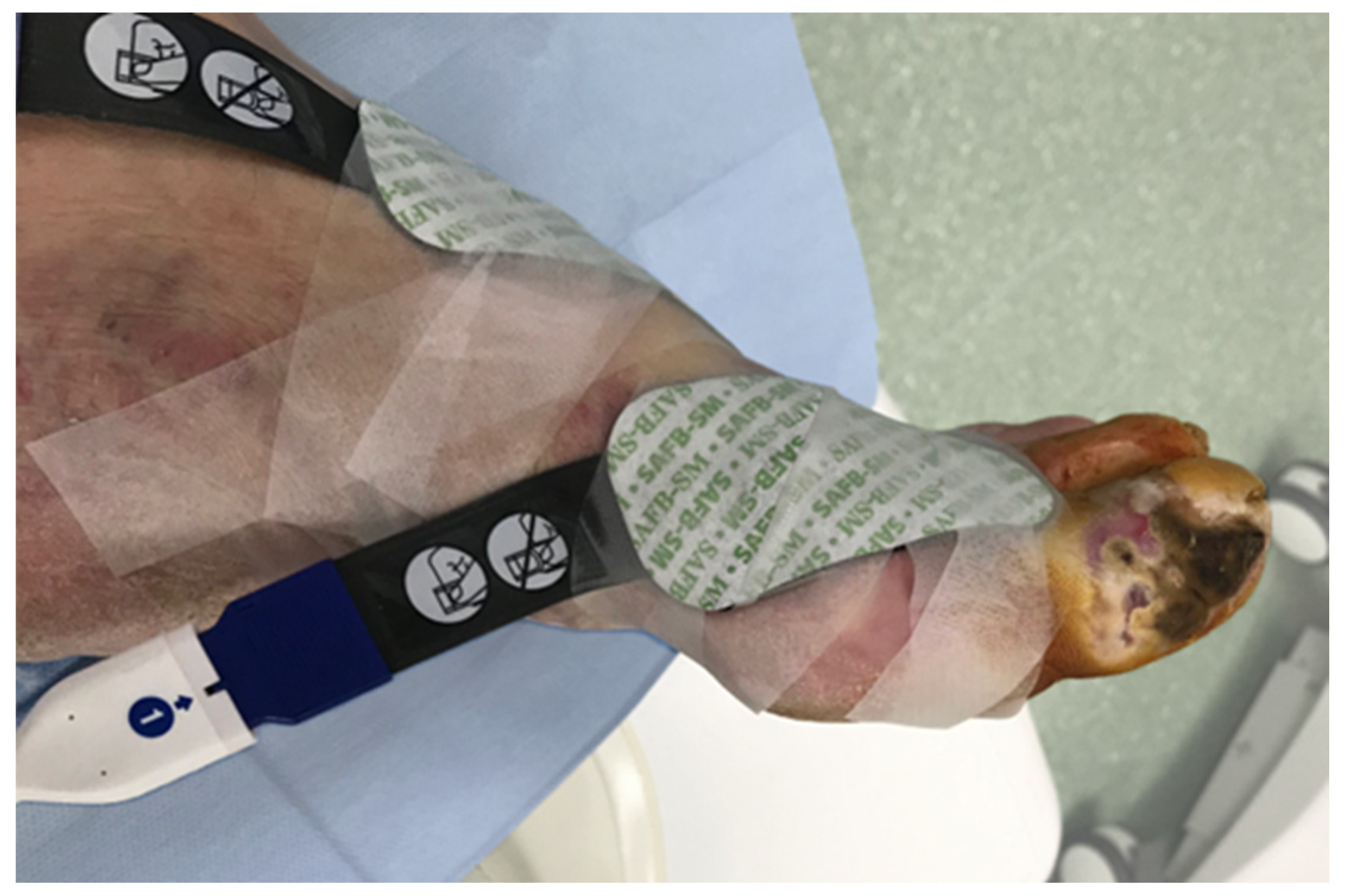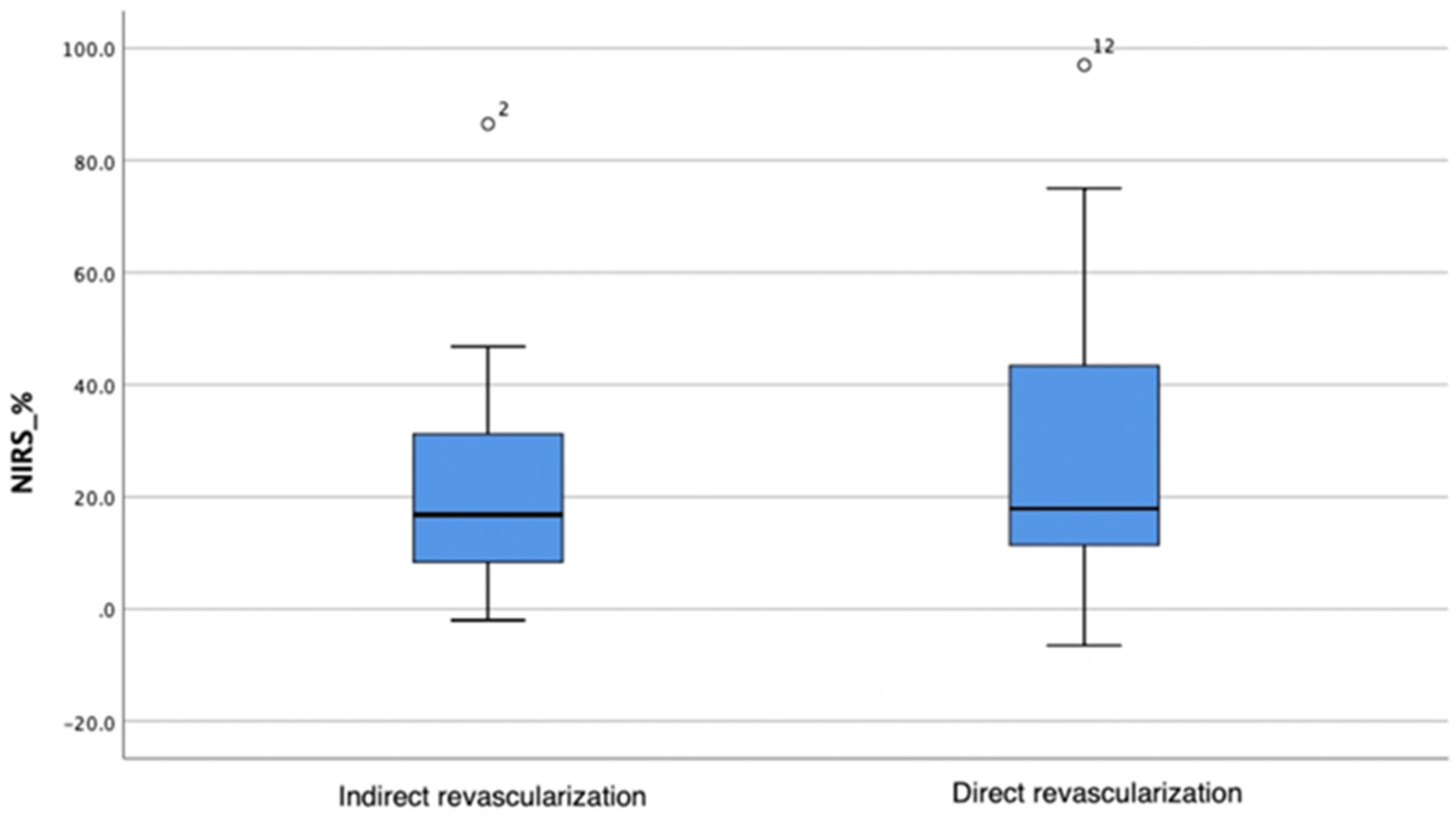Oxygen Saturation Increase in Ischemic Wound Tissues after Direct and Indirect Revascularization
Abstract
1. Introduction
2. Materials and Methods
2.1. Study Type and Ethics
2.2. Participants
2.3. Examination and Procedures
- M1α—mean of the first 50 measurements on sensor 1 (before revascularization);
- M2α—mean of the first 50 measurements on sensor 2 (before revascularization);
- M1ω—mean of the last 50 measurements on sensor 1 (after revascularization);
- M2ω—mean of the last 50 measurements on sensor 2 (after revascularization);
- MRα—mean of the first 50 measurements on the reference sensor (before revascularization);
- MRω—mean of the last 50 measurements on the reference sensor (after revascularization).
2.4. Statistical Analysis
3. Results
Post-Hoc Power Analysis
4. Discussion
5. Conclusions
Author Contributions
Funding
Institutional Review Board Statement
Informed Consent Statement
Data Availability Statement
Conflicts of Interest
References
- Díaz-Herrera, M.Á.; Martínez-Riera, J.R.; Verdú-Soriano, J.; Capillas-Pérez, R.M.; Pont-García, C.; Tenllado-Pérez, S.; Cunillera-Puértolas, O.; Berenguer-Pérez, M.; Gea-Caballero, V. Multicentre Study of Chronic Wounds Point Prevalence in Primary Health Care in the Southern Metropolitan Area of Barcelona. J. Clin. Med. 2021, 10, 797. [Google Scholar] [CrossRef]
- Sen, C.K. Human Wound and Its Burden: Updated 2020 Compendium of Estimates. Adv. Wound Care 2021, 10, 281–292. [Google Scholar] [CrossRef]
- Frykberg, R.G.; Banks, J. Challenges in the Treatment of Chronic Wounds. Adv. Wound Care 2015, 4, 560–582. [Google Scholar] [CrossRef]
- Canadian Agency for Drugs and Technologies in Health. Optimal Care of Chronic, Non-Healing, Lower Extremity Wounds: A Review of Clinical Evidence and Guidelines. In CADTH Rapid Response Reports; Canadian Agency for Drugs and Technologies in Health: Ottawa, ON, Canada, 2013. [Google Scholar]
- Li, W.W.; Carter, M.J.; Mashiach, E.; Guthrie, S.D. Vascular assessment of wound healing: A clinical review. Int. Wound J. 2017, 14, 460–469. [Google Scholar] [CrossRef] [PubMed]
- Salenius, J.; Suntila, M.; Ahti, T.; Huhtala, H.; Vaalasti, A.; Salmi, T.; Kimpimäki, T. Long-term Mortality among Patients with Chronic Ulcers. Acta Derm. Venereol. 2021, 101, adv00455. [Google Scholar] [CrossRef] [PubMed]
- Castilla, D.M.; Liu, Z.-J.; Velazquez, O.C. Oxygen: Implications for Wound Healing. Adv. Wound Care 2012, 1, 225–230. [Google Scholar] [CrossRef] [PubMed]
- Tandara, A.A.; Mustoe, T.A. Oxygen in Wound Healing—More than a Nutrient. World J. Surg. 2004, 28, 294–300. [Google Scholar] [CrossRef]
- Conte, M.S.; Bradbury, A.W.; Kolh, P.; White, J.V.; Dick, F.; Fitridge, R.; Mills, J.L.; Ricco, J.-B.; Suresh, K.R.; Murad, M.H.; et al. Global Vascular Guidelines on the Management of Chronic Limb-Threatening Ischemia. Eur. J. Vasc. Endovasc. Surg. 2019, 58, S1–S109.e33. [Google Scholar] [CrossRef]
- Špillerová, K.; Sörderström, M.; Albäck, A.; Venermo, M. The Feasibility of Angiosome-Targeted Endovascular Treatment in Patients with Critical Limb Ischemia and Foot Ulcer. Ann. Vasc. Surg. 2016, 30, 270–276. [Google Scholar] [CrossRef]
- Dilaver, N.; Twine, C.P.; Bosanquet, D.C. Editor’s Choice—Direct vs. Indirect Angiosomal Revascularisation of Infrapopliteal Arteries, an Updated Systematic Review and Meta-analysis. Eur. J. Vasc. Endovasc. Surg. 2018, 56, 834–848. [Google Scholar] [CrossRef]
- Jongsma, H.; Bekken, J.A.; Akkersdijk, G.P.; Hoeks, S.E.; Verhagen, H.J.; Fioole, B. Angiosome-directed revascularization in patients with critical limb ischemia. J. Vasc. Surg. 2017, 65, 1208–1219.e1. [Google Scholar] [CrossRef] [PubMed]
- Hou, X.; Guo, P.; Cai, F.; Lin, Y.; Zhang, J. Angiosome-Guided Endovascular Revascularization for Treatment of Diabetic Foot Ulcers with Peripheral Artery Disease. Ann. Vasc. Surg. 2022, 86, 242–250. [Google Scholar] [CrossRef]
- Bosanquet, D.C.; Glasbey, J.C.D.; Williams, I.M.; Twine, C.P. Systematic Review and Meta-analysis of Direct Versus Indirect Angiosomal Revascularisation of Infrapopliteal Arteries. Eur. J. Vasc. Endovasc. Surg. 2014, 48, 88–97. [Google Scholar] [CrossRef] [PubMed]
- Stimpson, A.L.; Dilaver, N.; Bosanquet, D.C.; Ambler, G.K.; Twine, C.P. Angiosome Specific Revascularisation: Does the Evidence Support It? Eur. J. Vasc. Endovasc. Surg. 2019, 57, 311–317. [Google Scholar] [CrossRef]
- Okazaki, J.; Matsuda, D.; Tanaka, K.; Ishida, M.; Kuma, S.; Morisaki, K.; Furuyama, T.; Maehara, Y. Analysis of wound healing time and wound-free period as outcomes after surgical and endovascular revascularization for critical lower limb ischemia. J. Vasc. Surg. 2018, 67, 817–825. [Google Scholar] [CrossRef]
- Utsunomiya, M.; Takahara, M.; Iida, O.; Yamauchi, Y.; Kawasaki, D.; Yokoi, Y.; Soga, Y.; Ohura, N.; Nakamura, M. Wound Blush Obtainment Is the Most Important Angiographic Endpoint for Wound Healing. JACC Cardiovasc. Interv. 2017, 10, 188–194. [Google Scholar] [CrossRef]
- Chiang, N.; Jain, J.K.; Sleigh, J.; Vasudevan, T. Evaluation of hyperspectral imaging technology in patients with peripheral vascular disease. J. Vasc. Surg. 2017, 66, 1192–1201. [Google Scholar] [CrossRef] [PubMed]
- Jens, S.; Marquering, H.A.; Koelemay, M.J.W.; Reekers, J.A. Perfusion Angiography of the Foot in Patients with Critical Limb Ischemia: Description of the Technique. Cardiovasc. Intervent. Radiol. 2015, 38, 201–205. [Google Scholar] [CrossRef] [PubMed]
- Montero-Baker, M.F.; Au-Yeung, K.Y.; Wisniewski, N.A.; Gamsey, S.; Morelli-Alvarez, L.; Mills, J.L.; Campos, M.; Helton, K.L. The First-in-Man “Si Se Puede” Study for the use of micro-oxygen sensors (MOXYs) to determine dynamic relative oxygen indices in the feet of patients with limb-threatening ischemia during endovascular therapy. J. Vasc. Surg. 2015, 61, 1501–1510.e1. [Google Scholar] [CrossRef]
- Boezeman, R.P.E.; Becx, B.P.; Van Den Heuvel, D.A.F.; Ünlü, Ç.; Vos, J.A.; De Vries, J.P.P.M. Monitoring of Foot Oxygenation with Near-infrared Spectroscopy in Patients with Critical Limb Ischemia Undergoing Percutaneous Transluminal Angioplasty: A Pilot Study. Eur. J. Vasc. Endovasc. Surg. 2016, 52, 650–656. [Google Scholar] [CrossRef]
- Mills, J.L.; Conte, M.S.; Armstrong, D.G.; Pomposelli, F.B.; Schanzer, A.; Sidawy, A.N.; Andros, G. The Society for Vascular Surgery Lower Extremity Threatened Limb Classification System: Risk stratification based on Wound, Ischemia, and foot Infection (WIfI). J. Vasc. Surg. 2014, 59, 220–234.e2. [Google Scholar] [CrossRef] [PubMed]
- Las Heras, K.; Igartua, M.; Santos-Vizcaino, E.; Hernandez, R.M. Chronic wounds: Current status, available strategies and emerging therapeutic solutions. J. Control. Release 2020, 328, 532–550. [Google Scholar] [CrossRef]
- Catella, J.; Long, A.; Mazzolai, L. What Is Currently the Role of TcPO2 in the Choice of the Amputation Level of Lower Limbs? A Comprehensive Review. J. Clin. Med. 2021, 10, 1413. [Google Scholar] [CrossRef]
- Scheeren, T.W.L.; Schober, P.; Schwarte, L.A. Monitoring tissue oxygenation by near infrared spectroscopy (NIRS): Background and current applications. J. Clin. Monit. Comput. 2012, 26, 279–287. [Google Scholar] [CrossRef] [PubMed]
- Jöbsis, F.F. Noninvasive, Infrared Monitoring of Cerebral and Myocardial Oxygen Sufficiency and Circulatory Parameters. Science 1977, 198, 1264–1267. [Google Scholar] [CrossRef] [PubMed]
- Baltrūnas, T.; Mosenko, V.; Mackevičius, A.; Dambrauskas, V.; Ašakienė, I.; Ručinskas, K.; Narmontas, P. The use of near-infrared spectroscopy in the diagnosis of peripheral artery disease: A systematic review. Vascular 2022, 30, 715–727. [Google Scholar] [CrossRef]
- Murkin, J.M.; Adams, S.J.; Novick, R.J.; Quantz, M.; Bainbridge, D.; Iglesias, I.; Cleland, A.; Schaefer, B.; Irwin, B.; Fox, S. Monitoring Brain Oxygen Saturation During Coronary Bypass Surgery: A Randomized, Prospective Study. Anesth. Analg. 2007, 104, 51–58. [Google Scholar] [CrossRef]
- Wang, Y.; Li, L.; Wang, T.; Zhao, L.; Feng, H.; Wang, Q.; Fan, L.; Feng, X.; Xiao, W.; Feng, K. The Efficacy of Near-Infrared Spectroscopy Monitoring in Carotid Endarterectomy: A Prospective, Single-Center, Observational Study. Cell Transplant. 2019, 28, 170–175. [Google Scholar] [CrossRef]
- Pennekamp, C.W.A.; Bots, M.L.; Kappelle, L.J.; Moll, F.L.; De Borst, G.J. The Value of Near-Infrared Spectroscopy Measured Cerebral Oximetry During Carotid Endarterectomy in Perioperative Stroke Prevention. A Review. Eur. J. Vasc. Endovasc. Surg. 2009, 38, 539–545. [Google Scholar] [CrossRef]
- Tan, R.; Green, D.; Jansen, S. Functional Near Infrared Spectroscopy in Peripheral Vascular Disease: Comparison with Existing Clinical Methods in Assessment of Foot Perfusion. Eur. J. Vasc. Endovasc. Surg. 2021, 62, 491–492. [Google Scholar] [CrossRef]
- Tokue, H.; Tokue, A.; Tsushima, Y. rSO2 Measurement Using NIRS for Lower-Limb Blood Flow Monitoring and Estimation of Safe Balloon Occlusion/Deflation Time in Patients with PAS Who Underwent PBOA during CS. Medicina 2023, 59, 1146. [Google Scholar] [CrossRef] [PubMed]
- Fujii, M.; Terashi, H. Angiosome and Tissue Healing. Ann. Vasc. Dis. 2019, 12, 147–150. [Google Scholar] [CrossRef] [PubMed]
- Varela, C.; Acín, F.; de Haro, J.; Bleda, S.; Esparza, L.; March, J.R. The Role of Foot Collateral Vessels on Ulcer Healing and Limb Salvage After Successful Endovascular and Surgical Distal Procedures According to an Angiosome Model. Vasc. Endovasc. Surg. 2010, 44, 654–660. [Google Scholar] [CrossRef] [PubMed]
- Jeon, E.Y.; Cho, Y.K.; Yoon, D.Y.; Kim, D.J.; Woo, J.J. Clinical outcome of angiosome-oriented infrapopliteal percutaneous transluminal angioplasty for isolated infrapopliteal lesions in patients with critical limb ischemia. Diagn. Interv. Radiol. 2015, 22, 52–58. [Google Scholar] [CrossRef]
- De Athayde Soares, R.; Brochado Neto, F.C.; Matielo, M.F.; Lehn, C.N.; Nakamura, E.T.; Godoy, M.R.; Cury, M.V.M.; Cury, M.H.; Sacilotto, R. Concept of Angiosome Does Not Affect Limb Salvage in Infrapopliteal Angioplasty. Ann. Vasc. Surg. 2016, 32, 34–40. [Google Scholar] [CrossRef]
- Fossaceca, R.; Guzzardi, G.; Cerini, P.; Cusaro, C.; Stecco, A.; Parziale, G.; Perchinunno, M.; De Bonis, M.; Carriero, A. Endovascular Treatment of Diabetic Foot in a Selected Population of Patients with Below-the-Knee Disease: Is the Angiosome Model Effective? Cardiovasc. Intervent. Radiol. 2013, 36, 637–644. [Google Scholar] [CrossRef]


| Inclusion Criteria | Exclusion Criteria |
|---|---|
| All presenting PAD patients 55–95 years old | Skin diseases preventing the use of NIRS |
| CLTI Rutherford V–VI | Life expectancy less than 12 months |
| CTO below the knee | Unavoidable amputation above ankle |
| Planned revascularization of at least one BTK artery | Blood oxygen saturation below 85% because of any comorbidities |
| No need for intervention above the knee |
| Variables | Direct Revascularization Group | Indirect Revascularization Group | p-Value |
|---|---|---|---|
| Age, years | 72.3 ± 7.8 | 77.1 ± 13.7 | >0.05 |
| Male | 7 (46.7%) | 10 (66.7%) | >0.05 |
| Diabetes mellitus | 10 (66.7%) | 6 (40%) | >0.05 |
| End-stage renal disease | 6 (40%) | 4 (26.7%) | >0.05 |
| CAD | 12 (80%) | 9 (60%) | >0.05 |
| Lesions (n = 30) | |
|---|---|
| Anterior tibial artery | 16 (53.3) |
| Posterior tibial artery | 8 (26.7) |
| Peroneal artery | 6 (20.0) |
| Sensor | NIRS rSO2 before the Reperfusion | NIRS rSO2 after the Reperfusion | p-Value |
|---|---|---|---|
| Sensor 1 | 58.0 ± 12.7 | 66.7 ± 11.6 | 0.001 |
| Sensor 2 | 57.6 ± 12.7 | 67.1 ± 14.0 | <0.001 |
| Patients (n = 30) | NIRS rSO2 Change after the Revascularization | |
|---|---|---|
| Indirect Revascularization | 15 (50) | 16.8 [25.7] |
| Direct Revascularization | 15 (50) | 17.9 [38.5] |
| Optimal Vessel (a) | Suboptimal Vessel (b) | |
|---|---|---|
| Angiosomal revascularization (1) | Subgroup 1a | Subgroup 1b |
| Non-angiosomal revascularization (2) | Subgroup 2a | Subgroup 2b |
Disclaimer/Publisher’s Note: The statements, opinions and data contained in all publications are solely those of the individual author(s) and contributor(s) and not of MDPI and/or the editor(s). MDPI and/or the editor(s) disclaim responsibility for any injury to people or property resulting from any ideas, methods, instructions or products referred to in the content. |
© 2024 by the authors. Licensee MDPI, Basel, Switzerland. This article is an open access article distributed under the terms and conditions of the Creative Commons Attribution (CC BY) license (https://creativecommons.org/licenses/by/4.0/).
Share and Cite
Račytė, A.; Pikturnaitė, G.; Baltrūnas, T.; Kalvaitis, E.; Vaitėnas, G.; Skrebūnas, A.; Baltrūnienė, V.; Ručinskas, K. Oxygen Saturation Increase in Ischemic Wound Tissues after Direct and Indirect Revascularization. Biomedicines 2024, 12, 367. https://doi.org/10.3390/biomedicines12020367
Račytė A, Pikturnaitė G, Baltrūnas T, Kalvaitis E, Vaitėnas G, Skrebūnas A, Baltrūnienė V, Ručinskas K. Oxygen Saturation Increase in Ischemic Wound Tissues after Direct and Indirect Revascularization. Biomedicines. 2024; 12(2):367. https://doi.org/10.3390/biomedicines12020367
Chicago/Turabian StyleRačytė, Austėja, Gabija Pikturnaitė, Tomas Baltrūnas, Evaldas Kalvaitis, Gediminas Vaitėnas, Arminas Skrebūnas, Vaida Baltrūnienė, and Kęstutis Ručinskas. 2024. "Oxygen Saturation Increase in Ischemic Wound Tissues after Direct and Indirect Revascularization" Biomedicines 12, no. 2: 367. https://doi.org/10.3390/biomedicines12020367
APA StyleRačytė, A., Pikturnaitė, G., Baltrūnas, T., Kalvaitis, E., Vaitėnas, G., Skrebūnas, A., Baltrūnienė, V., & Ručinskas, K. (2024). Oxygen Saturation Increase in Ischemic Wound Tissues after Direct and Indirect Revascularization. Biomedicines, 12(2), 367. https://doi.org/10.3390/biomedicines12020367





